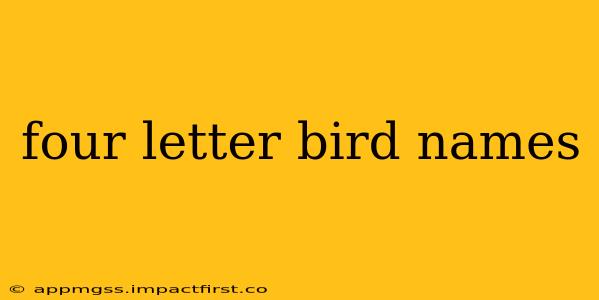Birdwatching is a captivating hobby, offering a window into the diverse and fascinating world of avian life. Part of the joy comes from learning the names of these beautiful creatures, and today, we're focusing on a specific subset: four-letter bird names. These concise names often belie the complexity and beauty of the birds they represent. Let's explore some of these captivating creatures and answer some common questions bird enthusiasts might have.
What are some common four-letter bird names?
This is a great starting point, as many people are simply curious about the birds themselves. Several four-letter bird names are relatively common, depending on your geographic location. These include:
- Dove: A ubiquitous bird, doves are known for their gentle cooing and peaceful nature. Many species exist worldwide.
- Teal: A type of dabbling duck, teals are often vibrantly colored and known for their graceful movements on the water.
- Wren: These small, active birds are known for their melodious songs and often found in dense vegetation.
- Crow: These highly intelligent birds are easily recognizable by their all-black plumage and distinctive calls.
- Hawk: A broad term encompassing a variety of raptors, known for their hunting prowess and sharp vision.
Are there any four-letter bird names that are less common?
While the names listed above are frequently encountered, a more thorough search reveals some less common, yet still fascinating four-letter avian names. These often represent species found in more specific regions or are less widely known to the casual birdwatcher. Further research into regional bird guides will reveal a greater diversity of possibilities.
What about birds with names that are close to four letters?
Sometimes, the search for four-letter bird names leads to those that are just a letter or two off. These birds are still worthy of consideration and can broaden our understanding of avian diversity. Think of names like "Robin" (five letters) or "Swift" (five letters), iconic and well-known birds.
How are bird names chosen?
The naming conventions for birds are fascinating in their own right, often reflecting the bird's appearance, behavior, or the location where it was discovered. Many names have Latin roots, contributing to the complex and often historical etymology behind the names. Ornithologists play a vital role in naming new species and confirming existing classifications.
Where can I find more information on bird names?
Excellent resources for further exploration include:
- Field guides: Regional field guides are indispensable for bird identification and provide detailed information on each species, including their names and characteristics.
- Online databases: Many online databases, such as the Cornell Lab of Ornithology's website, offer extensive information on bird species, their distribution, and their names.
- Ornithological societies: Joining a local or national ornithological society provides access to experts, resources, and a community of fellow bird enthusiasts.
This article provides a solid foundation for understanding four-letter bird names. Remember that the world of ornithology is vast and ever-evolving, offering endless opportunities for learning and discovery. Happy birdwatching!
